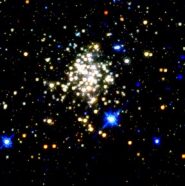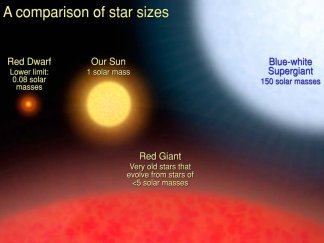No Fat Stars
Stars in the Milky Way can weigh no more than 150 times the sun's mass.
Share this:
- Share via email (Opens in new window) Email
- Click to share on Facebook (Opens in new window) Facebook
- Click to share on X (Opens in new window) X
- Click to share on Pinterest (Opens in new window) Pinterest
- Click to share on Reddit (Opens in new window) Reddit
- Share to Google Classroom (Opens in new window) Google Classroom
- Click to print (Opens in new window) Print
By Emily Sohn
There’s a limit to how big most things can get. Some people are really tall, but no one is as tall as a house. Cats can get really fat, but there’s never been a tabby as heavy as a truck. And so on.
Now, astronomer Don Figer of the Space Telescope Science Institute in Baltimore has discovered that the size of a star may have a limit, too. No stars in our galaxy, he estimates, can weigh more than 150 times the mass of our sun.
 |
|
The Arches cluster is a crowded collection of about 2,000 stars near the center of the Milky Way.
|
| Don Figer (Space Telescope Science Institute) and NASA |
This conclusion comes from observations of an area near the center of the Milky Way called the Arches cluster. The cluster is between 2 million and 2.5 million years old, and stars are still forming there. It contains about 2,000 stars.
Figer thought that the Arches cluster would be a good place to search for the galaxy’s biggest stars because it’s still fairly young. Massive stars have short lives, so it wouldn’t make sense to look at a cluster that was much older than Arches. It also wouldn’t make sense to look at much younger ones because stars in young clusters are still hideen behind gas and dust.
The Arches cluster was also promising because it’s big. Its total mass is that of about 10,000 suns. In theory, it could hold at least 18 stars weighing more than 130 times the mass of the sun.
 |
|
This illustration compares the different masses of stars. The lightest stars are red dwarfs. They can be as small as 1/12 the mass of the sun. The heaviest stars are blue-white supergiants. They may get as large as 150 solar masses. The sun is between the lightweight and heavyweight stars. A red giant may actually be much larger in size than a supergiant, but its weight is much smaller—often just a few solar masses. |
| NASA, ESA, and Ann Feild (Space Telescope Science Institute) |
Using the Hubble Space Telescope to gauge the weight of hundreds of stars in the Arches cluster, Figer found no stars this big. This means, he concluded, that there must be an upper limit to the size of a star—perhaps about 150 times the sun’s mass.
Astronomers are just beginning to understand the processes behind star birth. No one yet knows what determines the limits on their growth. Figer plans to study clusters of different ages to find out more.—E. Sohn
Going Deeper:
Cowen, Ron. 2005. Weighing in on a star: A stellar size limit. Science News 167(March 12):164-165. Available at http://www.sciencenews.org/articles/20050312/fob4.asp .
Additional information about the discovery of a stellar size limit can be found at hubblesite.org/newscenter/newsdesk/archive/releases/2005/05/ (Space Telescope Science Institute).






